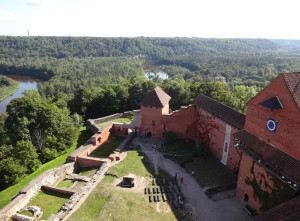A lot of attention is paid to the Daugava, the biggest and longest river in Latvia, that goes through the middle of the country – but few outside of Latvia know about the Gauja river, which is the longest river exclusively in Latvia (though it does form the border between Latvia and Estonia for a short bit south of Valka).
Just like the Daugava, a lot of history and romanticism is tied up with the Gauja river. It flows through northern Latvia, passing through the towns of Valmiera and Sigulda, and also passes the outskirts of CÄ“sis. These are the most prominent towns in northern Latvia.
Courtyard of Turaida Castle, with the Gauja in the background. Photo taken by me, September 2014.
The name “Gauja” is believed to be from the Livonian and Estonian words for “birch” – kõuvõ and kõiv, respectively. Given its northern Latvian roots, this makes sense – “birch river”. The Gauja meanders through rolling countryside and some beautiful sandstone cliffs. Its depth can change regularly, due to its sand and gravel base. It empties into the Gulf of RÄ«ga near the town of Carnikava.
Numerous battles have been fought on the Gauja’s shores, the earliest recorded one being the Battle of Turaida in 1211, which was fought between the Estonians and the Turaida Livonians, who had converted to Christianity and were backed by the German crusaders. The Estonians had intended on bringing the Livonians onto their side, and then together going after the Germans in RÄ«ga, but it did not work out that way. According to the stories, the Estonians came down the Gauja in 300 ships, and upon their defeat, attempted to escape with these ships to the Gulf of RÄ«ga, but their paths were blocked, and thus had to abandon them to flee by land.
Just like the Daugava, the Gauja also makes an appearance in song. I don’t know what influences a songwriter to choose one river over the other. The Gauja appears in the song “Å eit ir Latvija” (Here is Latvia), with the lines “Jo Å¡eit ir Latvija, Å¡eit ir Gaujmala, Å¡eit ir mÅ«su tÄ“vu dzimtene” (For here is Latvia, here are the shores of the Gauja, here is our fathers’ homeland). It takes an even more prominent role in “Å e kur lÄ«go priežu meži” (Here, where the pine forests sway), appearing in almost every verse. The first verse (and sometimes chorus) goes “Å e kur lÄ«go priežu meži, esmu dÄrgÄm saitÄ“m siets, Å¡e ir mana tÄ“vu zeme, esmu dzimis Gaujmalietis” (Here where the pine forests sway, I have strong ties, this is my father’s land, I was born a Gaujmalietis).”Gaujmalietis” means “someone from the shores of the Gauja”.
The Gauja also has a namesake – there is also a Gauja river in Venezuela. This is the river that contains Angel Falls, the highest uninterrupted waterfall in the world. How does a river in Venezuela come to be named after a Latvian river? This is because of Aleksandrs Laime, a Latvian explorer, who is believed to be the first European to reach the base of the falls, in 1946. He then later ascended the falls as well, and named the river for the Gauja in his homeland.
This goes to show that Latvians are, indeed, everywhere!

